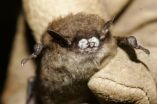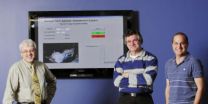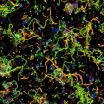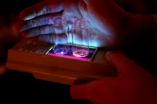(Press-News.org) Scientists aboard the Royal Research Ship James Cook have discovered a new set of deep-sea volcanic vents in the chilly waters of the Southern Ocean. The discovery is the fourth made by the research team in three years, which suggests that deep-sea vents may be more common in our oceans than previously thought.
Using an underwater camera system, the researchers saw slender mineral spires three metres tall, with shimmering hot water gushing from their peaks, and gossamer-like white mats of bacteria coating their sides. The vents are at a depth of 520 metres in a newly-discovered seafloor crater close to the South Sandwich Islands, a remote group of islands around 500 kilometres south-east of South Georgia.
"When we caught the first glimpse of the vents, the excitement was almost overwhelming," says Leigh Marsh, a University of Southampton PhD student who was on scientific watch at the time of the discovery.
Deep-sea vents are hot springs on the seafloor, where mineral-rich water nourishes lush colonies of microbes and deep-sea animals. In the three decades since scientists first encountered vents in the Pacific, around 250 have been discovered worldwide. Most have been found on a chain of undersea volcanoes called the mid-ocean ridge, however, and very few are known in the Antarctic.
"We're finding deep-sea vents more rapidly than ever before," says expedition leader Professor Paul Tyler of the University of Southampton's School of Ocean and Earth Science, which is based at the National Oceanography Centre, Southampton. "And we're finding some in places other than at mid-ocean ridges, where most have been seen before."
By studying the new vents, the team hope to understand more about the distribution and evolution of life in the deep ocean, the role that deep-sea vents play in controlling the chemistry of the oceans, and the diversity of microbes that thrive in different conditions beneath the waves.
The researchers were exploring 'Adventure Caldera', a crater-like hole in the seafloor three kilometres across and 750 metres deep at its deepest point. Despite its size, Adventure Caldera was only discovered last year by geophysicists from the British Antarctic Survey.
The new vents are the fourth set to be discovered around Antarctica in three expeditions since 2009. Their discovery is part of a project funded by the UK Natural Environment Research Council (NERC), which involves researchers from the National Oceanography Centre in Southampton, the British Antarctic Survey in Cambridge, the Universities of Southampton, Newcastle, Oxford, Bristol and Leeds, and Woods Hole Oceanographic Institution in the US.
The current expedition is scheduled to end in Punta Arenas, Chile, on 22 February 22, and the team are posting regular updates and answering questions from school pupils via their expedition website at http://www.thesearethevoyages.net/
INFORMATION:
More deep-sea vents discovered
2011-02-15
ELSE PRESS RELEASES FROM THIS DATE:
Culling can't control deadly bat disease
2011-02-15
Culling will not stop the spread of a deadly fungus that is threatening to wipe out hibernating bats in North America, according to a new mathematical model.
White-nose syndrome, which is estimated to have killed over a million bats in a three year period, is probably caused by a newly discovered cold-adapted fungus, Geomyces destructans. The new model examines how WNS is passed from bat to bat and concludes that culling would not work because of the complexity of bat life history and because the fungal pathogen occurs in the caves and mines where the bats live.
"Because ...
NIH study finds 2 pesticides associated with Parkinson's disease
2011-02-15
New research shows a link between use of two pesticides, rotenone and paraquat, and Parkinson's disease. People who used either pesticide developed Parkinson's disease approximately 2.5 times more often than non-users.
The study was a collaborative effort conducted by researchers at the National Institute of Environmental Health Sciences (NIEHS), which is part of the National Institutes of Health, and the Parkinson's Institute and Clinical Center in Sunnyvale, Calif.
"Rotenone directly inhibits the function of the mitochondria, the structure responsible for making ...
Playtime helps bind generations
2011-02-15
This release is available in French.
Montreal, February 14, 2010 – A new study has confirmed an old adage: A family that plays together stays together. Researchers from Concordia University and Wilfrid Laurier University examined the ways grandparents can maintain close ties with their adult grandchildren. True to the old maxim, recreation emerged as the glue sealing intergenerational bonds.
"Leisure is vital in the formation of bonds that last from generation to generation," says lead author Shannon Hebblethwaite, a professor in Concordia University's Department ...
Stem cell transplants help kidney damage
2011-02-15
Tampa, Fla. (Feb. 14, 2011) – Transplanting autologous renal progenitor cells (RPCs), (kidney stem cells derived from self-donors), into rat models with kidney damage from pyelonephritis - a type of urinary infection that has reached the kidney - has been found to improve kidney structure and function.
The study, authored by a research team from the Tehran University of Medical Sciences, is published in the current issue of Cell Medicine [1(3)] and is freely available on-line at: http://www.ingentaconnect.com/content/cog/cm .
"Advancements in stem cell therapies and ...
Researchers working toward automating sedation in intensive care units
2011-02-15
Researchers at the Georgia Institute of Technology and the Northeast Georgia Medical Center are one step closer to their goal of automating the management of sedation in hospital intensive care units (ICUs). They have developed control algorithms that use clinical data to accurately determine a patient's level of sedation and can notify medical staff if there is a change in the level.
"ICU nurses have one of the most task-laden jobs in medicine and typically take care of multiple patients at the same time, so if we can use control system technology to automate the task ...
Quest for designer bacteria uncovers a 'Spy'
2011-02-15
ANN ARBOR, Mich.---Scientists have discovered a molecular assistant called Spy that helps bacteria excel at producing proteins for medical and industrial purposes.
Bacteria are widely used to manufacture proteins used in medicine and industry, but the bugs often bungle the job. Many proteins fall apart and get cut up inside the bacteria before they can be harvested. Others collapse into useless tangles instead of folding properly, as they must in order to function normally.
A research team led by James Bardwell, who is a professor of molecular, cellular and developmental ...
New scholarly paper reveals 100 new species of lichenized fungi
2011-02-15
CHICAGO, IL – In an unprecedented coming-out party, 100 newly discovered species are revealed to the world in a single scholarly paper coordinated by Field Museum scientists.
The 100 organisms are lichens, a type of fungi that form associations with algae and populate environments from arctic tundra to tropical rain forests. And the usual inattention bestowed upon new lichens is one reason for aggregating so many new ones in a single paper in the Feb. 18 issue of the journal Phytotaxa.
It is estimated that about 100,000 fungal species, including 17,500 lichens, have been ...
Choosing your neighbors: MBL scientists see how microbes relate in space
2011-02-15
MBL, WOODS HOLE, MA—Like people in cities, microbes often live in complex communities that contain many different microbial types. Also like us, microbes tend to gravitate to and "hang out" with certain other types in their community, more than with the rest. And sometimes, when opportunities arise, they move to more favorable locations.
But until recently, scientists have not been able to look at a microbial community and distinguish the spatial relationship of more than 2 or 3 kinds of microbes at once.
Now, a microscopy technique developed at the Marine Biological ...
Jewel-toned organic phosphorescent crystals: A new class of light-emitting material
2011-02-15
ANN ARBOR, Mich.---Pure organic compounds that glow in jewel tones could potentially lead to cheaper, more efficient and flexible display screens, among other applications.
University of Michigan researcher Jinsang Kim and his colleagues have developed a new class of material that shines with phosphorescence---a property that has previously been seen only in non-organic compounds or organometallics.
Kim and his colleagues made metal-free organic crystals that are white in visible light and radiate blue, green, yellow and orange when triggered by ultraviolet light. ...
Treating the aging knee as an organ
2011-02-15
DETROIT – The human body is made up of several organs composed of tissues that enable them to perform a particular function. The heart circulates blood; the brain is the micro-neuro center of the body; the lungs bring in oxygen and release carbon dioxide.
The failure of any one of these tissue systems can cause serious health issues, even death. When components of the organ are fixed, typically the organ functions better. For instance, unclogging a blocked artery with a balloon stent improves blood circulation to and from the heart.
Henry Ford Hospital researcher Fred ...






